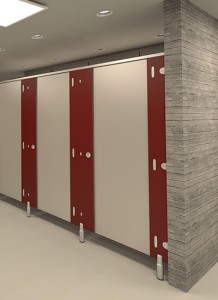Whatever type and size of your business, as an employer, you must ensure that you provide correct toilet facilities to keep the right side of employment, health and safety and disability laws. Nobody wants to be caught short and end up with the costs, hassle and poor publicity that come with getting things wrong.
We’ve learned a thing or two about bathroom and toilet cubicles over the years so, while this blog is not intended to act as formal legal advice, it ought to give you a handy introduction to all the things you need to consider.

Toilet Cubicles and The Health & Safety Executive
In the UK, The Health & Safety Executive, often shortened to HSE, is tasked with keeping everyone healthy in workplaces. As an employer, it is important to understand your responsibilities across a range of subjects from operating machinery to providing first aid. Failing to comply with their rules can lead to hefty fines. The good news is that when it comes to bathrooms, the HSE publishes useful guidelines. They’re worth a read in detail, but we’ve summarised them here for the sake, if you’ll excuse the pun, of convenience.
Let’s start with the number of toilets you need. The relevant legislation is known by the catchy title ‘Workplace (Health, Safety and Welfare) Regulations 1992. Regulation 20, Sanitary Conveniences.’ It prescribes the number of loos you need depending on the size of your workforce. There are different rules for mixed, women-only and men-only spaces.
For mixed or women-only spaces the minimum requirements
● 1-5 employees
○ 1 toilet cubicle & 1 washbasin
● 6-25 employees
○ 2 toilet cubicles & 2 washbasins
● 26-50 employees
○ 3 toilet cubicles & 3 washbasins
● 51-75 employees
○ 4 toilet cubicles & 4 washbasins
● 76-100 employees
○ 5 toilet cubicles & 5 washbasins
For men-only spaces, there are urinals to consider too of course.
● 1-15 employees
○ 1 toilet cubicle & 1 urinal
● 16-30 employees
○ 2 toilet cubicles & 1 urinal
● 31-45 employees
○ 2 toilet cubicles & 2 urinals
● 46-60 employees
○ 3 toilet cubicles & 2 urinals
● 61-75 employees
○ 3 toilet cubicles & 3 urinals
● 76-90 employees
○ 4 toilet cubicles & 3 urinals
● 91-100 employees
○ 4 toilet cubicles & 4 urinals
The HSE also prescribes minimum features you have to include in your bathrooms. So as well as bathroom cubicles and hand-washing basins, you will need to consider the following.
● separate facilities for male and female employees except where each toilet is in a room that can be locked from the inside
● a safe place to dispose of sanitary dressings
● cleanliness including tiled surfaces
● toilet paper supply
● good lighting and ventilation
● hot and cold running water
● hand soap or other washing agents
● a way of drying hands, such as paper towels or a hot-air dryer
● showers where necessary for manual or dirty work
The HSE does allow employers to use temporary toilet facilities or encourage employees to use nearby public washrooms but only as a last resort in an emergency and not if this is deemed a simple cost-saving measure.
These rules are for employers and workplaces. Public spaces have a different set of guidelines that vary with use and size. A retail space over 1,000 sq m in floor space, for example, is required to have one toilet per 500 male customers plus one for every additional 1,000 male customers, or part thereof. For women, the figure is one toilet per 500 female customers, plus one per every additional 200 female customers, or part thereof. Schools, colleges, government buildings, theatres, gyms and leisure centres all have similar guidelines that are worth checking.
Bathroom Cubicles and The Equalities Act
The Equalities Act exists to make sure they do not discriminate against employees. This includes those with a disability and everyone needs to have equal access to bathrooms and toilets. The Act itself doesn’t set any specific minimum requirements for loos but uses the wording ‘reasonable adjustment’ to describe steps that employers should take to provide equal opportunities for disabled employees. The definition of ‘reasonable’ changes over time and adjustments are an ongoing obligation.
To comply with the Act, businesses must remove barriers to disabled people and make any reasonable adjustments required for them to work. Importantly, they need to do this proactively rather than wait for a disabled person to contact them or complain. As an employer, stating that creating equal toilet facilities is ‘too expensive’ or ‘disruptive’ without evidence is not considered mitigation.
In practice, for most employers, when it comes to bathrooms, this means ensuring you have a suitable accessible toilet cubicle on site. The recommended (or at least minimum) size for a disabled washroom space is 2,200mm in length (depth) and 1,500mm in width. Accessible toilets also need specific facilities including grab rails, alarms and so on.
Although the Equalities Act does not specify the features required in disabled toilets beyond referring to reasonable adjustments, they are described in Part M of UK Building Regulations. Although it is important to note compliance with building regulations doesn’t automatically meet the obligations and duties set out in the Equality Act. If you’re concerned about your compliance with the Equalities Act, it pays to ask one of the many disability organisations who can advise.
Toilet Cubicles and Gender
Gendered toilets are still required by law. As of July 4th 2022, the UK Government’s Department of Levelling Up, Housing and Communities decided that all new public buildings need to be fitted with single-sex bathrooms, marked male and female. Gender-neutral bathrooms are still allowed and businesses can have them as a preference but they must, however, also retain single-sex facilities.
It is important to be clear about the term gender-neutral. It implies a bathroom where handwashing facilities are shared by men and women. If you have standalone lockable rooms or cubicles that include handwashing facilities, so there’s no shared space, this becomes a gender-free, unisex toilet.
Problems with gender often occur because of poor or inadequate signage. If you’re choosing to include gender-neutral bathrooms, you need to make clear it is a shared space and men and women will be using them. A unisex or gender-free standalone bathroom needs to be well-signposted as an unshared, standalone space. This means the traditional white pictogram depicting the classic male and female silhouettes may be outdated.
The key message is you still need to consider single-sex spaces to comply with UK law and, in these days of change, signpost your facilities clearly to keep everyone happy.
In summary, laws around bathrooms exist to make sure safe, clean and acceptable toilet and washroom facilities are made available to everyone equally. They are often overlooked but, for employers, play a key part in maintaining a motivated and happy workforce.











Connect with Cubicle Centre